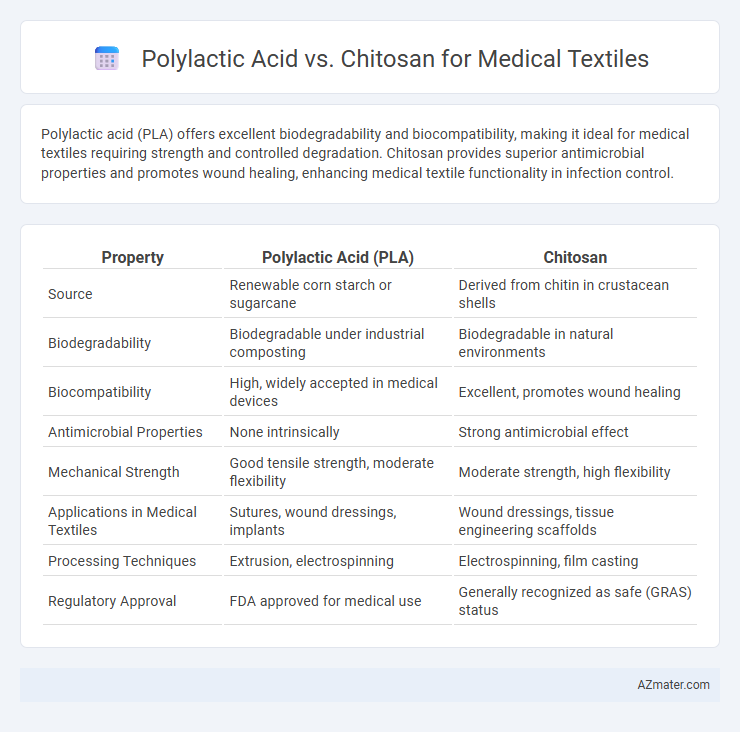Polylactic acid (PLA) offers excellent biodegradability and biocompatibility, making it ideal for medical textiles requiring strength and controlled degradation. Chitosan provides superior antimicrobial properties and promotes wound healing, enhancing medical textile functionality in infection control.
Table of Comparison
| Property | Polylactic Acid (PLA) | Chitosan |
|---|---|---|
| Source | Renewable corn starch or sugarcane | Derived from chitin in crustacean shells |
| Biodegradability | Biodegradable under industrial composting | Biodegradable in natural environments |
| Biocompatibility | High, widely accepted in medical devices | Excellent, promotes wound healing |
| Antimicrobial Properties | None intrinsically | Strong antimicrobial effect |
| Mechanical Strength | Good tensile strength, moderate flexibility | Moderate strength, high flexibility |
| Applications in Medical Textiles | Sutures, wound dressings, implants | Wound dressings, tissue engineering scaffolds |
| Processing Techniques | Extrusion, electrospinning | Electrospinning, film casting |
| Regulatory Approval | FDA approved for medical use | Generally recognized as safe (GRAS) status |
Introduction to Medical Textile Biomaterials
Polylactic acid (PLA) and chitosan are prominent biomaterials in medical textiles, valued for their biocompatibility and biodegradability. PLA offers excellent mechanical strength and controlled degradation rates, making it suitable for wound dressings and implantable devices. Chitosan provides antimicrobial properties and promotes tissue regeneration, enhancing infection control and healing in medical textile applications.
Overview of Polylactic Acid (PLA) in Medical Textiles
Polylactic acid (PLA) is a biodegradable, bio-based polymer commonly used in medical textiles due to its excellent biocompatibility, mechanical strength, and ability to support cell growth. Derived from renewable resources such as corn starch or sugarcane, PLA offers controlled degradation rates suitable for wound dressings, surgical sutures, and tissue engineering scaffolds. Its versatility and eco-friendly nature make PLA a preferred material in developing sustainable medical textiles with reduced environmental impact.
Overview of Chitosan in Medical Textiles
Chitosan is a biodegradable, biocompatible polysaccharide derived from chitin, widely used in medical textiles for its antimicrobial, hemostatic, and wound-healing properties. Its ability to promote cell adhesion and tissue regeneration makes it ideal for wound dressings, sutures, and antibacterial fabric coatings. Compared to polylactic acid, chitosan offers superior bioactivity and intrinsic antimicrobial effects, enhancing the functionality of medical textile applications.
Biocompatibility: PLA vs Chitosan
Polylactic acid (PLA) and chitosan both exhibit strong biocompatibility, essential for medical textiles, but chitosan offers superior cell adhesion and antimicrobial properties due to its natural polysaccharide structure. PLA, a biodegradable polyester derived from renewable resources, provides excellent mechanical strength and controlled degradation rates but lacks inherent antimicrobial effects. The choice between PLA and chitosan depends on the specific medical textile application, balancing mechanical performance with biological interaction.
Antimicrobial Properties Comparison
Polylactic acid (PLA) offers biodegradability and biocompatibility but has limited inherent antimicrobial properties, often requiring incorporation of antimicrobial agents for enhanced efficacy. Chitosan, derived from chitin, exhibits strong natural antimicrobial activity against a broad spectrum of bacteria and fungi, making it highly effective for medical textiles aimed at infection control. Comparative studies reveal chitosan's superior ability to inhibit microbial growth without additional chemicals, positioning it as a preferred choice for antimicrobial medical textile applications.
Biodegradability and Environmental Impact
Polylactic acid (PLA) and chitosan are both biodegradable polymers used in medical textiles, with PLA derived from renewable resources like corn starch, offering complete biodegradability under industrial composting conditions. Chitosan, sourced from chitin in crustacean shells, biodegrades naturally in various environments due to its enzymatic breakdown processes, making it highly eco-friendly. PLA's environmental impact is often lower than petroleum-based plastics but requires controlled conditions for degradation, while chitosan's biocompatibility and faster environmental degradation make it ideal for sustainable medical textile applications.
Mechanical Strength and Durability
Polylactic acid (PLA) demonstrates superior mechanical strength and durability compared to chitosan in medical textiles, offering high tensile strength and resistance to wear. Chitosan provides excellent biocompatibility and antimicrobial properties but exhibits lower mechanical robustness and faster degradation under physiological conditions. PLA's durability and mechanical stability make it more suitable for load-bearing medical textile applications requiring prolonged use.
Applications in Wound Healing and Dressings
Polylactic acid (PLA) and chitosan are prominent biopolymers in medical textiles, with PLA offering excellent biodegradability and mechanical strength ideal for wound dressings that require structural support and controlled degradation. Chitosan provides inherent antimicrobial properties and promotes hemostasis, making it highly effective in accelerating wound healing and preventing infections in dressings. Combining PLA's durability with chitosan's bioactivity enhances the performance of advanced wound care products by balancing protection, healing, and biocompatibility.
Cost-Effectiveness and Scalability
Polylactic acid (PLA) offers superior cost-effectiveness in medical textiles due to its low raw material expenses and compatibility with mass production technologies such as melt spinning, enabling large-scale manufacturing at competitive prices. Chitosan, derived from crustacean shells, generally incurs higher costs and presents scalability challenges due to complex extraction and purification processes, limiting its widespread adoption. While PLA supports efficient scalability and affordability, chitosan's bioactive properties may justify its higher cost in specialized medical textile applications where antimicrobial function is critical.
Future Prospects and Innovations
Polylactic acid (PLA) and chitosan are emerging as critical biopolymers in medical textiles, with PLA offering superior biodegradability and mechanical strength ideal for wound dressings and sutures. Chitosan's inherent antimicrobial properties and biocompatibility present significant innovation potential for infection-resistant medical fabrics. Future prospects center on enhancing composite materials that blend PLA and chitosan to optimize healing efficiency, durability, and environmental sustainability in next-generation medical textiles.

Infographic: Polylactic acid vs Chitosan for Medical textile
 azmater.com
azmater.com